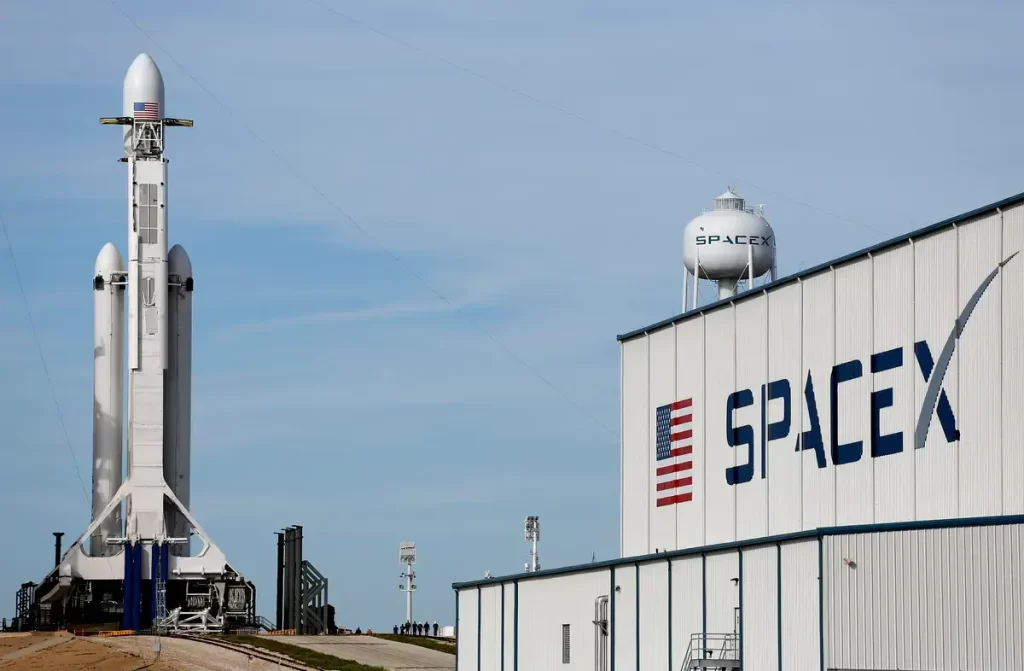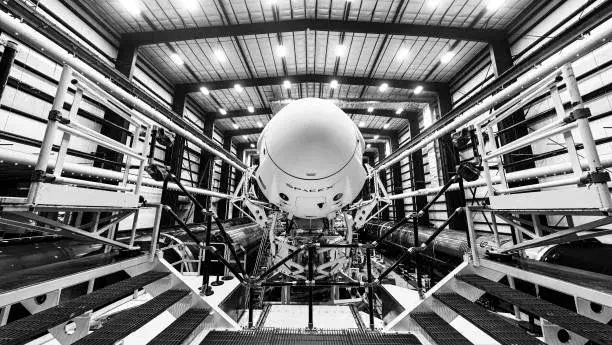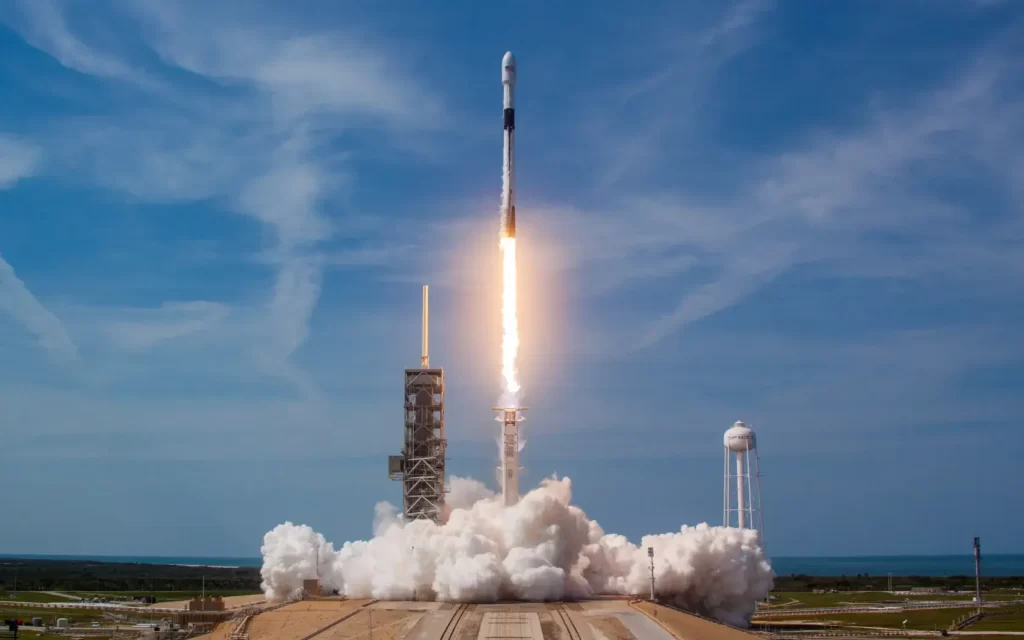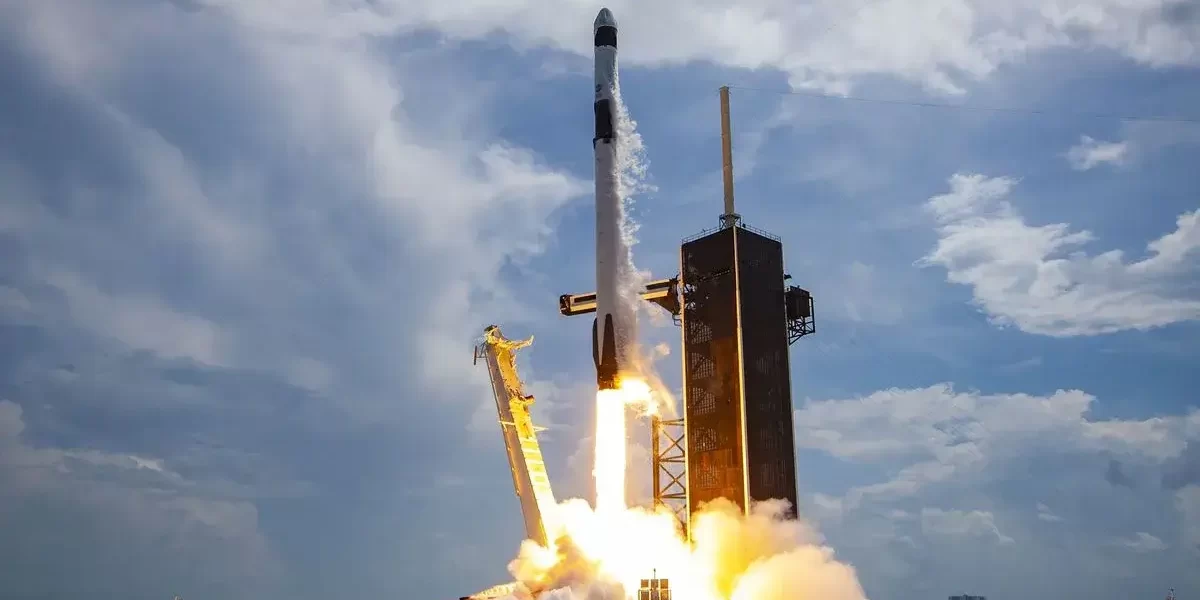SpaceX’s Falcon 9: The Moon has always fascinated humanity, serving as a symbol of curiosity and exploration. Over the years, scientists and space agencies have made remarkable discoveries about our celestial neighbor, but there is still much to learn. One area that has piqued the interest of researchers is the Moon’s south pole, believed to hold the key to unlocking the mysteries of water on the lunar surface.
The significance of landing on the Moon’s south pole lies in the potential presence of water ice. The Moon’s surface is known to be barren and desolate, devoid of any atmosphere or liquid water. However, scientists have gathered evidence suggesting that the lunar south pole might harbor water ice in permanently shadowed regions. If this hypothesis is proven true, it could revolutionize our understanding of the Moon and have far-reaching implications for future space exploration.
Exploring the Moon’s south pole is crucial for several reasons. Firstly, water is an essential resource for human survival. If we can find a source of water on the Moon, it would significantly reduce the cost and complexity of space missions. Instead of carrying vast amounts of water from Earth, astronauts could potentially extract and utilize local resources, making long-term lunar colonization a realistic possibility.
Secondly, water on the Moon could provide valuable insights into the origins and evolution of our solar system. By studying the isotopic composition of lunar water, scientists can gain a deeper understanding of the processes that shaped our planet and its neighboring celestial bodies. This knowledge could have profound implications for our understanding of the universe and our place within it.
Lastly, the discovery of water on the Moon could open up new avenues for space exploration and commercialization. Water can be broken down into its constituent elements, hydrogen and oxygen, which are the building blocks of rocket fuel. By harnessing the resources available on the Moon, we could establish refueling stations and launch pads, enabling more ambitious missions to Mars and beyond. Additionally, the Moon’s water could also serve as a valuable resource for future space tourism and mining operations.
In light of these potential benefits, the recent launch of the lunar lander Odysseus by SpaceX holds great promise. Equipped with advanced scientific instruments, Odysseus will venture to the Moon’s south pole, gathering crucial data and paving the way for future missions and discoveries. As we eagerly await the results of this groundbreaking mission, the exploration of the Moon’s south pole represents a significant leap forward in our quest to unlock the secrets of the universe.

The Search for Water on the Moon
The search for water on the Moon has captivated scientists and space enthusiasts alike. While the Moon’s surface appears inhospitable and devoid of any liquid water, there is mounting evidence suggesting the presence of water ice in the lunar south pole. Understanding the origin and distribution of water on the Moon is crucial for future space missions and the potential colonization of our celestial neighbor.
Scientists have proposed several theories about the presence of water on the Moon. One prevailing hypothesis suggests that water may have been delivered to the Moon through comets or asteroids that collided with its surface. These icy bodies could have deposited water in the permanently shadowed craters near the lunar south pole, where temperatures are extremely cold and sunlight rarely reaches.
To detect water on the Moon, scientists have employed various instruments and techniques. One such method is the use of remote sensing instruments, such as spectrometers, which can analyze the reflected sunlight or emitted thermal radiation from the lunar surface. By studying the specific wavelengths of light absorbed or emitted by water molecules, scientists can identify the presence and abundance of water ice.
In addition to remote sensing, scientists have also conducted direct measurements of the lunar surface. For example, the Lunar Reconnaissance Orbiter (LRO), launched by NASA in 2009, carried instruments capable of detecting water ice in shadowed regions. These measurements have provided valuable insights into the distribution and characteristics of lunar water, confirming the existence of water ice in select areas.
The discovery of water ice on the Moon has significant implications for future space missions. Water can be extracted and purified to provide drinking water, breathable oxygen, and even rocket fuel. By utilizing local resources, astronauts could establish sustainable bases on the Moon, reducing reliance on Earth for essential supplies. Furthermore, the availability of water could enable the production of propellant for deep space missions, making interplanetary travel more feasible and cost-effective.
As we continue to explore the Moon’s south pole and unravel the mysteries of lunar water, it is essential to develop techniques for extracting and utilizing this precious resource. Scientists and engineers are actively researching methods to mine, extract, and store lunar water, laying the groundwork for future manned missions and the sustainable utilization of lunar resources. The search for water on the Moon represents a crucial step in our pursuit of interstellar exploration and the colonization of other celestial bodies.
The Role of the SpaceX Falcon 9 Rocket in Space Exploration
SpaceX, founded by visionary entrepreneur Elon Musk, has revolutionized the space industry with its innovative rockets and ambitious missions. Among its impressive fleet, the Falcon 9 rocket stands out as a workhorse, delivering satellites into orbit and resupplying the International Space Station. The Falcon 9’s reliability and versatility have made it an indispensable tool for space exploration, including the recent launch of the lunar lander Odysseus.
The Falcon 9 rocket is a two-stage launch vehicle powered by Merlin engines. Its first stage, known as the booster, is capable of vertical takeoff and landing, making it reusable. This groundbreaking technology has significantly reduced the cost of space launches, as the booster can be recovered and refurbished for future missions. Reusability is a key aspect of SpaceX’s strategy to make space travel more accessible and sustainable.
The Falcon 9’s success lies in its impressive performance capabilities. It can deliver payloads of up to 22,800 kilograms (50,300 pounds) to low Earth orbit and 8,300 kilograms (18,300 pounds) to geostationary transfer orbit. This versatility allows SpaceX to accommodate a wide range of missions, from deploying small satellites to conducting complex interplanetary missions. The Falcon 9’s track record of successful launches and reliable performance has earned it the trust of customers and space agencies around the world.
In the context of lunar exploration, the Falcon 9 plays a critical role in delivering payloads to the Moon’s vicinity. By launching spacecraft like Odysseus, SpaceX is providing the necessary infrastructure to conduct scientific investigations and pave the way for future manned missions. The Falcon 9’s robustness and payload capacity make it an ideal choice for delivering lunar landers, rovers, and other scientific instruments to the Moon’s surface.
Furthermore, the Falcon 9’s reusability makes it an economically viable option for lunar missions. By recovering and refurbishing the booster, SpaceX can significantly reduce the cost of launching payloads to the Moon. This cost-saving measure is essential for enabling sustained lunar exploration and the eventual establishment of a lunar outpost.
As SpaceX continues to push the boundaries of space exploration, the Falcon 9 rocket remains at the forefront of their pioneering efforts. With each successful launch, it brings us closer to a future where space travel is commonplace, and the colonization of other celestial bodies becomes a reality. The Falcon 9’s reliability, reusability, and impressive performance have solidified its place as a game-changer in the realm of space exploration.

Overview of the Lunar Lander Odysseus and Its Capabilities
The lunar lander Odysseus, affectionately named after the legendary Greek hero, represents a significant milestone in lunar exploration. Developed by SpaceX, in collaboration with NASA and other partners, Odysseus is equipped with state-of-the-art scientific instruments designed to unlock the secrets of the Moon’s south pole.
Odysseus is a robotic lander specifically designed for soft landings on the lunar surface. It combines advanced propulsion systems, precise navigation capabilities, and cutting-edge scientific instruments to carry out its mission objectives. The lander’s primary goal is to search for water ice in the permanently shadowed craters near the Moon’s south pole, where the conditions are believed to be favorable for water accumulation.
To accomplish this, Odysseus is equipped with a suite of scientific instruments that can analyze the lunar surface and subsurface. These instruments include a high-resolution camera system, a spectrometer for mineral analysis, and a ground-penetrating radar to detect and characterize subsurface structures. By combining data from these instruments, scientists hope to gain a comprehensive understanding of the lunar south pole’s composition and potential for harboring water ice.
Additionally, Odysseus carries a sample collection system, allowing it to gather lunar soil and rock samples for analysis. These samples will provide valuable insights into the Moon’s geological history and shed light on the processes that shaped our celestial neighbor. By studying the samples in detail, scientists can unravel the mysteries of the Moon’s formation and evolution, contributing to our understanding of the early solar system.
Odysseus is also equipped with communication and navigation systems to facilitate data transmission and ensure accurate positioning on the lunar surface. These systems enable real-time communication with mission control and provide vital information for precise landing and maneuvering.
The successful deployment of Odysseus on the lunar surface will be a testament to the capabilities of SpaceX’s technology and the collaboration between various scientific institutions. By leveraging the expertise of engineers, scientists, and space agencies, Odysseus represents a collective effort to unlock the secrets of the Moon and pave the way for future human exploration.
As we eagerly await the data and discoveries that Odysseus will deliver, it is clear that this lunar lander represents a significant milestone in our quest for knowledge and exploration. Odysseus embodies the spirit of human curiosity and the relentless pursuit of understanding our place in the universe.
Challenges of Landing on the Moon’s South Pole
Landing on the Moon’s south pole presents a unique set of challenges and hurdles that must be overcome to ensure the success of lunar missions. The harsh lunar environment, coupled with the technical complexities of landing in uncharted territories, makes the Moon’s south pole a formidable destination for exploration.
One of the primary challenges of landing on the Moon’s south pole is the rugged and treacherous terrain. The region is characterized by rugged mountains, deep craters, and uneven surfaces, posing a significant risk to spacecraft during descent and landing. Navigating through these obstacles requires advanced guidance and control systems to ensure a safe and precise landing.
Another challenge is the Moon’s lack of atmosphere. Unlike Earth, the Moon does not have a substantial atmosphere to slow down spacecraft during descent. As a result, landing on the lunar surface requires precise calculations and control of the spacecraft’s trajectory and velocity. Even a slight deviation from the intended path could result in a catastrophic landing failure.
Furthermore, the Moon’s south pole experiences extreme temperature variations. In the permanently shadowed craters, temperatures can reach as low as -230°C (-382°F). These extreme temperatures pose a significant challenge to spacecraft and their delicate instruments, requiring robust thermal control systems to ensure their functionality and longevity.
Another critical challenge is communication. The Moon’s south pole’s topography and the absence of a direct line of sight to Earth can hinder communication between the spacecraft and mission control. To overcome this, relay satellites in lunar orbit and advanced communication systems are employed to establish a reliable and continuous link.
These challenges highlight the importance of thorough mission planning, rigorous testing, and advanced engineering solutions. The successful landing of spacecraft like fiatogel on the Moon’s south pole requires the expertise and collaboration of scientists, engineers, and space agencies from around the world. Overcoming these challenges will not only pave the way for future lunar missions but also contribute to our understanding of deep space exploration and colonization.

The Scientific Objectives of the Lunar Lander Mission
The scientific objectives of the lunar lander mission are twofold: to search for water ice and to gain insights into the Moon’s geological history and composition. These objectives are of paramount importance for understanding the Moon’s evolution, the potential for human habitation, and the broader context of our solar system.
The search for water ice is a primary focus of the lunar lander mission. By studying the Moon’s south pole region, where water ice is believed to accumulate in permanently shadowed craters, scientists hope to confirm its presence and determine its abundance. This crucial information will not only inform future lunar missions but also shed light on the origins of water on Earth and other celestial bodies.
To accomplish this, the lunar lander is equipped with advanced scientific instruments capable of analyzing the lunar surface and subsurface. The high-resolution camera system will capture detailed images of the landing site, allowing scientists to study the topography and geology of the region. The spectrometer will analyze the composition of the lunar surface, identifying minerals and potential signs of water ice. The ground-penetrating radar will provide valuable insights into the subsurface structure, helping scientists understand the distribution and characteristics of water ice deposits.
In addition to the search for water ice, the lunar lander mission aims to uncover the Moon’s geological history and composition. By collecting and analyzing lunar soil and rock samples, scientists can reconstruct the Moon’s past and gain insights into its formation and evolution. These samples will provide valuable information about the Moon’s geology, impact history, and volcanic activity, contributing to our understanding of the early solar system.
Furthermore, the lunar lander mission will also study the Moon’s regolith, the layer of loose material covering the lunar surface. By analyzing the regolith’s properties, scientists can better understand the lunar environment and its potential for supporting future human exploration and habitation. This knowledge will inform future mission planning and the development of technologies required for sustained lunar operations.
The scientific objectives of the lunar lander mission are ambitious and far-reaching. By addressing fundamental questions about the Moon’s water content, geological history, and composition, this mission represents a crucial step towards unraveling the mysteries of our celestial neighbor and expanding our knowledge of the universe.
The Potential Implications of Finding Water on the Moon
The discovery of water on the Moon would have profound implications for future space exploration and the potential colonization of our celestial neighbor. Water is a critical resource for human survival and has the potential to revolutionize the way we conduct space missions and establish sustainable habitats on other celestial bodies.
Finding water on the Moon would significantly reduce the cost and complexity of space missions. Instead of carrying vast amounts of water from Earth, astronauts could potentially extract and purify local resources, such as lunar water ice. This would enable long-term human presence on the Moon and serve as a stepping stone for further exploration of the solar system.
Also read: Water Crisis Tackling: Solutions and Collaborative Action











